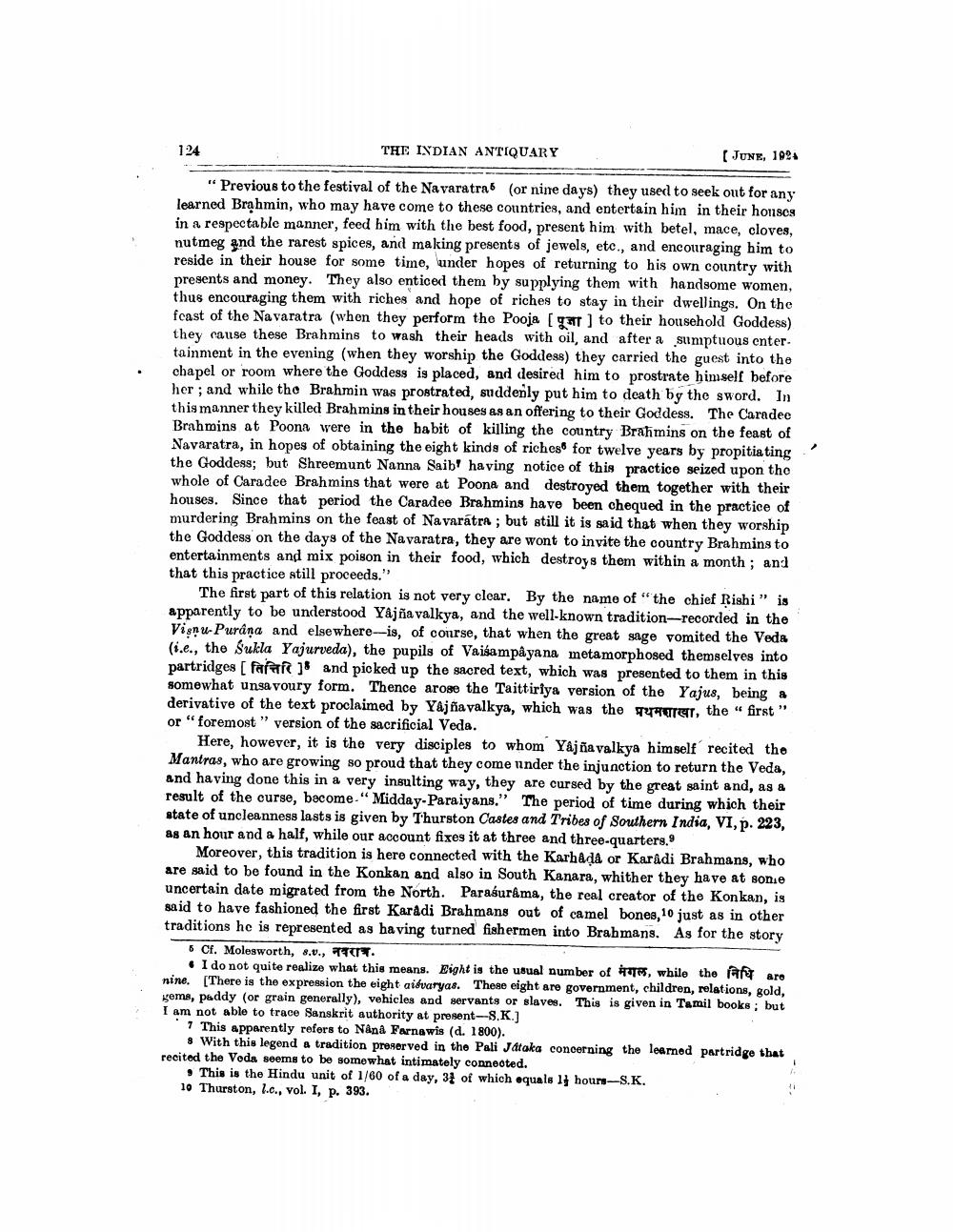________________
124
THE INDIAN ANTIQUARY
(JUNE, 1024
"Previous to the festival of the Navaratra 6 (or nine days) they used to seek out for any learned Brahmin, who may have come to these countries, and entertain him in their honses in a respectable manner, feed him with the best food, present him with betel, mace, cloves, nutmeg and the rarest spices, and making presents of jewels, etc., and encouraging him to reside in their house for some time, under hopes of returning to his own country with presents and money. They also enticed them by supplying them with handsome women, thus encouraging them with riches and hope of riches to stay in their dwellings. On the fcast of the Navaratra (when they perform the Pooja (ar) to their household Goddess) they cause these Brahmins to wash their heads with oil, and after a sumptuous enter. tainment in the evening when they worship the Goddess) they carried the guest into the chapel or room where the Goddess is placed, and desired him to prostrate himself before her; and while tho Brahmin was prostrated, suddenly put him to death by the sword. In this manner they killed Brahmins in their houses as an offering to their Goddess. The Caradee Brahmins at Poona were in the habit of killing the country Brahmins on the feast of Navaratra, in hopes of obtaining the eight kinds of riches for twelve years by propitiating the Goddess; but Shreemunt Nanna Saib' having notice of this practice seized upon the whole of Caradee Brahmins that were at Poona and destroyed them together with their houses. Since that period the Caradee Brahmins have been chequed in the practice of murdering Brahmins on the feast of Navarátra ; but still it is said that when they worship the Goddess on the days of the Navaratra, they are wont to invite the country Brahmins to entertainments and mix poison in their food, which destroys them within a month; and that this practice still proceeds."
The first part of this relation is not very clear. By the name of "the chief Rishi” is apparently to be understood Yajna valkya, and the well-known tradition-recorded in the Visnu-Purana and elsewhere--is, of course, that when the great sage vomited the Veda (i.e., the Sukla Yajurveda), the pupils of Vaišampayana metamorphosed themselves into partridges [fare ]$ and picked up the sacred text, which was presented to them in this somewhat unsavoury form. Thence arose the Taittiriya version of the Yajus, being a derivative of the text proclaimed by Yajñavalkya, which was the h er, the “first" or "foremost " version of the sacrificial Veda.
Here, however, it is the very disciples to whom Yajña valkya himself recited the Mantras, who are growing so proud that they come under the injunction to return the Veda, and having done this in a very insulting way, they are cursed by the great saint and, as a result of the curse, bacome." Midday-Paraiyans." The period of time during which their state of uncleanness lasts is given by Thurston Castes and Tribes of Southern India, VI, p. 223, as an hour and a half, while our account fixes it at three and three-quarters.
Moreover, this tradition is here connected with the Karbada or Karadi Brahmans, who are said to be found in the Konkan and also in South Kanara, whither they have at sone uncertain date migrated from the North. Parasurama, the real creator of the Konkan, is said to have fashioned the first Karadi Brahmans out of camel bones, 10 just as in other traditions he is represented as having turned fishermen into Brahmans. As for the story
5 Cf. Molesworth, 8.0., T .
• I do not quite realize what this means. Eight is the usual number of it, while the fan are nine. (There is the expression the eight aidvaryas. These eight are government, children, relations, gold, yems, paddy (or grain generally), vehicles and servants or slaves. This is given in Tamil books; but I am not able to trace Sanskrit authority at present--S.K.)
7 This apparently refers to Nana Farnawis (d. 1800).
& With this legend a tradition preserved in the Pali Jataka concerning the learned partridge that recited the Voda seems to be somewhat intimately conneoted.
This is the Hindu unit of 1/60 of a day, 34 of which equals lj hours-S.K. 10 Thurston, 1.c., vol. I, p. 393.




